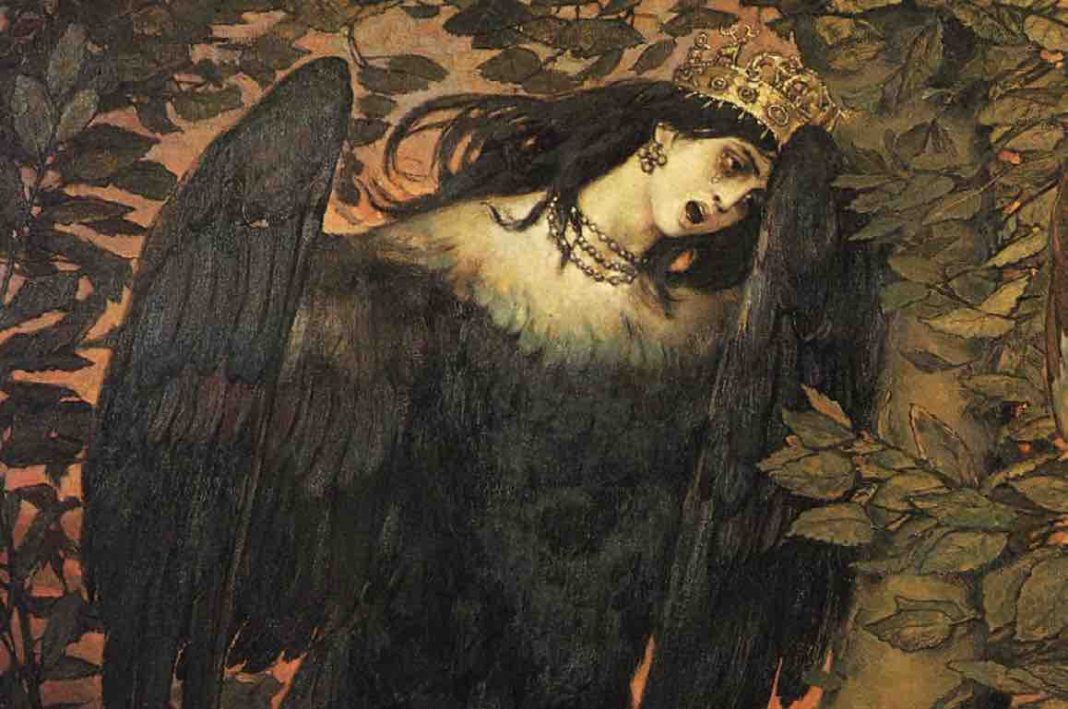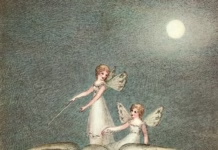by Sara Cleto and Brittany Warman
Feature Image:
Detail from Sirin and Alkonost: The Birds of Joy and Sorrow (1896), by Viktor Vasnetsov
“First to the Sirens ye shall come, that taint
The minds of all men whom they can acquaint
With their attractions.
Whosoever shall,
For want of knowledge mov’d, but hear the call
Of any Siren, he will so despise
Both wife and children, for their sorceries,
That never home turns his affection’s stream,
Nor they take joy in him, nor he in them.
The Sirens will so soften with their song
(Shrill, and in sensual appetite so strong)”
—Homer, The Odyssey, translated by George Chapman
We’ve all heard of sirens, but their song remains elusive. Are they birds? Women? Murderers? Musicians?
It depends on who is telling the story.
Sirens are always a mix of the human and the avian, but that mixture is delightfully unstable. In Greek art, they have been painted and sculpted as birds capped with oversize women’s heads, with prominent feathers and scaly feet. But they have also been drawn with bird legs and beaks, with wings and without. They’ve been little birds with female faces, or sparrows from the chest up and human below. Sometimes, they have fish tails rather than legs at all. In art, they’re often shown carrying harps, lyres, and other instruments to accompany their strikingly beautiful voices.
Even more fantastically, sometimes they’re depicted as part bird, part man, though such representations have been scarce for many hundreds of years!
Greek mythology tells us of the danger that sirens pose, painting them as monsters who lived to lure men to their deaths. Harnessing the enchantment of their own voices and the magic of their instruments, they’d play music so sublime and irresistible that sailors would shipwreck their vessels just to be closer to the sound.
In Homer’s epic The Odyssey, the hero Odysseus hears tales of the sirens and determines to hear their notorious and deadly song for himself. He plugs his sailors’ ears with beeswax but ties himself to the mast of his ship so that he may hear them without jumping to his death in the sea. Having ordered his men not to untie him no matter what he says, Odysseus becomes the only known man to survive the experience of a siren’s song. Some later stories speculate that the sirens are so distraught over their failure that they seek their own deaths beneath the waves.
According to Ovid, the sirens were once the companions of Persephone, goddess of spring and the underworld. After she is kidnapped by Hades, the god of the underworld, the sirens beg for wings so that they can search the world for their lost friend. Perhaps their song, then, is a song of grief and a punishment for all men because of the cruel actions of one god.
Through the fish tails that some sirens wear, these mythical creatures are also connected to mermaids, fellow temptresses of the sea. One need only look to Hans Christian Andersen’s “The Little Mermaid” to note the similar emphasis on the voice that both figures share.
The enigmatic, enchanting siren has served as inspiration for countless stories, songs, novels, poems, and other works of art. Indeed, some view them as being related to the Muses themselves. They are, after all, profoundly connected to music. From John William Waterhouse’s eerie painting The Siren to the Starbucks logo to Disney’s The Little Mermaid, sirens and their kin saturate our culture, reminding us what it is to sing, to listen, and to yearn.






























